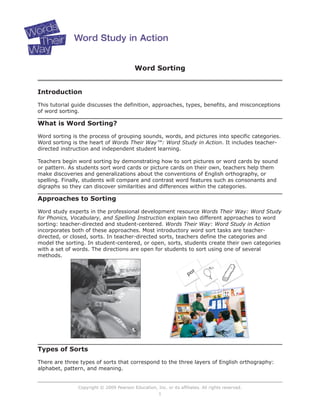More Related Content
Similar to Tg wtw word_sorting (20)
More from Jennifer Evans (20)
Tg wtw word_sorting
- 1. Copyright © 2009 Pearson Education, Inc. or its affiliates. All rights reserved.
1
Word Sorting
Introduction
This tutorial guide discusses the definition, approaches, types, benefits, and misconceptions
of word sorting.
What is Word Sorting?
Word sorting is the process of grouping sounds, words, and pictures into specific categories.
Word sorting is the heart of Words Their Way™: Word Study in Action. It includes teacher-
directed instruction and independent student learning.
Teachers begin word sorting by demonstrating how to sort pictures or word cards by sound
or pattern. As students sort word cards or picture cards on their own, teachers help them
make discoveries and generalizations about the conventions of English orthography, or
spelling. Finally, students will compare and contrast word features such as consonants and
digraphs so they can discover similarities and differences within the categories.
Approaches to Sorting
Word study experts in the professional development resource Words Their Way: Word Study
for Phonics, Vocabulary, and Spelling Instruction explain two different approaches to word
sorting: teacher-directed and student-centered. Words Their Way: Word Study in Action
incorporates both of these approaches. Most introductory word sort tasks are teacher-
directed, or closed, sorts. In teacher-directed sorts, teachers define the categories and
model the sorting. In student-centered, or open, sorts, students create their own categories
with a set of words. The directions are open for students to sort using one of several
methods.
Types of Sorts
There are three types of sorts that correspond to the three layers of English orthography:
alphabet, pattern, and meaning.
- 2. Copyright © 2009 Pearson Education, Inc. or its affiliates. All rights reserved.
2
Alphabet
In an Alphabet sort, students compare and contrast words by sound. They do this so they
can categorize similar sounds and associate them with letters and letter combinations,
syllable patterns, and spelling conventions. For example, words spelled with –op like top,
pop, and hop, are compared with words spelled with –ot like hot, cot, or pot.
Pattern
Next, students compare and contrast words by looking at consistent spelling patterns. For
example, words spelled with –oi like join or coin, are compared with words spelled with
–oy like joy or annoy. Both sets of words have the same sound, but each follows a unique
spelling pattern.
- 3. Copyright © 2009 Pearson Education, Inc. or its affiliates. All rights reserved.
3
Meaning
Finally, students categorize words and word parts by meaning, use, and parts of speech.
For example, adjectives that end in –y like chilly, misty, or breezy are compared to adverbs
ending in –ly like quickly, quietly, or smoothly.
Benefits of Sorting
Some of the benefits of word sorting are that it’s interactive, it promotes higher-level
thinking skills, and it provides oral language development opportunities that build on
students’ prior knowledge.
Words Their Way: Word Study in Action also facilitates differentiated instruction by allowing
you to choose appropriate practice opportunities for students based on their stage of
development. It does not teach students to rely on rote memorization or recitation of
spelling rules. Word sorts can also be used across content areas and in diverse classroom
environments.
- 4. Copyright © 2009 Pearson Education, Inc. or its affiliates. All rights reserved.
4
Sorting Misconceptions
One misconception regarding sorting is that it’s hands-on and voices off. Sorting is
hands-on, but it’s certainly not voices off! Students use oral language and vocalize sorts
independently, with partners or as a whole group. This helps cement their learning of word
sorts.
Another misconception is that words can only be sorted one time. Actually, mastery is
proven by increased speed and accuracy within a sort. Sorts can and should be used
multiple times.
The last misconception about sorting is that there must be a specific feature for each sort.
While there can be a specific feature or focus for a sort, student-directed or open sorts
are a great way to tap into student thinking. These sorts will help teachers gain a greater
understanding of your students’ thinking and learning.
Review
This guide looked at the definition, approaches and types of word sorts: alphabetic, pattern,
and meaning. The benefits and misconceptions of word sorting with Words Their Way: Word
Study in Action were also discussed.
For more information on Words Their Way: Word Study in Action, please look for the other
tutorials on myPearsonTraining.com.
